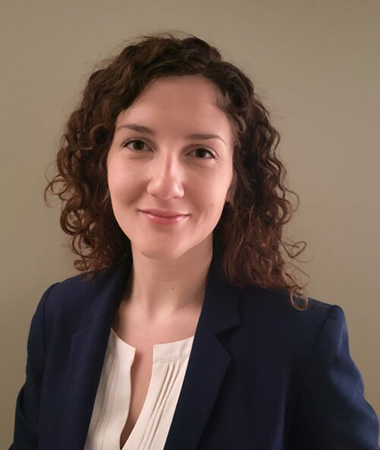Science in Service: Shaping Federal Support of Scientific Research
Social psychologist Elizabeth Necka shares her experiences as a program officer at the National Institute on Aging

Dr. Elizabeth (Liz) Necka is a program director in the Individual and Behavioral Processes Branch of the Division of Behavioral and Social Research at the National Institute on Aging (NIA). Necka directs a portfolio of basic and translational research focused on interpersonal processes in aging and how they relate to health and well-being.
“Scientific research is the corner of American prosperity and provides clear pathways for improving Americans’ lives. … [K]eep America’s future on track by making federal support of scientific research a national priority.”
Representative George K. Butterfield, 2014
With these words, Representative George K. Butterfield (D-NC) in 2014 echoed one of the central tenets of Vannevar Bush’s Science: The Endless Frontier, which was published nearly 70 years prior. Bush argued that “since health, well-being, and security are proper concerns of Government, scientific progress is, and must be, of vital interest to Government.”

These statements from Rep. Butterfield were included in a Dear Colleague letter (official correspondence sent by one member of Congress to others) in which he urged his colleagues to support the President’s budget request for the National Science Foundation (NSF). During that same Congress, I and a group of fellow graduate students representing the American Psychological Association’s Science Student Council engaged in advocacy efforts to encourage Congressional support of behavioral and social science research, which had recently come under targeted attacks.
The attacks were not entirely unfair—the 2012 special issue of Perspectives on Psychological Science on replicability in psychological science, for instance, was still top of mind, and NSF had recently convened a workshop on “Robust Research in the Social, Behavioral, and Economic Sciences” to investigate how to enhance scientific rigor in the research it supported. And yet, examples of behavioral and social scientific advances relevant for national prosperity abounded. For example, a recent 61-million-person experiment had demonstrated the power of social networks to mobilize voters, bringing an estimated additional 340,000 voters to the polls. Another intervention that took less than an hour to complete improved the academic and health outcomes of minority students for at least 3 years. Clearly, social and behavioral scientific advances were demonstrating pathways for improving Americans’ lives, a message we aimed to convey to our congressional representatives.
Junctions between science and policy
As one of the graduate students engaged in those advocacy efforts, this first foray into science policy and government relations made me realize the importance of having behavioral and social scientists in civil service—throughout the federal government but also specifically as program officers at federal agencies that fund behavioral and social science research. Program officers are subject-matter experts who manage a portfolio of research awards. Many program officers at federal funding agencies began in academia, conducting the same kind of research as that conducted by the grantees whose projects they oversee.
In their role as program officers, these scientists-turned-civil-servants interface both with other scientists who are actively conducting research and with leadership at federal agencies responsible for allocating funds to scientific research. They traverse through these different worlds to develop initiatives that both advance national priorities and address the needs of, or obstacles faced by, the research community. They also serve as subject-matter experts for communications and legislative affairs offices at those funding agencies, who interact with external stakeholders such as the taxpayers and Congress. As such, program officers play an important role in shaping the type of research that is solicited and supported by federal funding agencies. Federal funding supports approximately one-fifth of all research that is done in our country. The program officers also influence how the research is interpreted and valued. They help ensure that federal dollars are ultimately allocated to robust, rigorous, and replicable research, which cumulatively will promote scientific progress that truly advances our nation’s health, well-being, and prosperity.
Today, I am a program officer at the National Institute on Aging (NIA) at the National Institutes of Health (NIH). Being part of the federal research enterprise is one of the most gratifying aspects of my job. Though the specific tasks of a program officer differ from agency to agency and even from institute to institute within NIH, we all serve as a junction between the scientists who are doing the research and the policymakers who allocate funding for the research. It is a privilege to speak with scientists daily about the newest research they are conducting (and trying to get funded) in their labs. It’s also a privilege to amplify innovative and impactful findings from research that we fund to institute leadership and to our communications and legislative affairs offices, who publicize the discoveries beyond NIH.
Day-to-day work
Though the duties of a program officer can vary dramatically depending on the government agency or institute in which they and their portfolio of research are housed, I tend to characterize my day-to-day work at NIA as falling into roughly three categories: science, administration, and being part of a large organization. Though the time spent in each category of work changes on a daily basis, my time is roughly evenly divided between these three categories in any given year. “Science” includes, but is not limited toI, activities such as
- speaking to prospective grantees about their project ideas;
- providing technical assistance, and helping scientists understand the fit of their projects with NIA’s funding priorities;
- reading articles and attending conferences to stay abreast of scientific findings;
- designing workshops, roundtables, and other meetings to identify gaps in the literature and opportunities where focused investment of funds can help advance the field;
- developing Requests for Applications (RFAs) to solicit targeted research projects;
- writing commentaries and perspective pieces for journal publication; and
- contributing scientific input to large projects where NIH has substantial investment (often called cooperative agreements).
“Administration” includes, but is not limited to
- monitoring progress on grants and other awards to ensure that the projects are in compliance with NIH policies, using funds prudently, and meeting milestones on an appropriate timeline;
- helping create and/or staying abreast of changing policies (such as NIH’s definition of a clinical trial or new data-sharing requirements) that ensure adequate stewardship of taxpayer dollars;
- reviewing submitted applications to ensure they are compliant with federal policies and regulations prior to scientific peer review and, in the event of a meritorious application, formal release of award; and
- providing input to internal stakeholders such as agency leadership regarding issues arising with ongoing funded projects.
Finally, “being part of a large organization” includes meetings (so many meetings!) to ensure that processes run smoothly. Just as everyone in a lab or department participates in various committees or the development of standard operating procedures to facilitate day-to-day operations of the lab or department, working as a civil servant and a program officer means engaging with various other entities of the organization to keep the wheels greased. This can be as mundane as attending regular organizational meetings or completing paperwork, or it can be as exciting as working with our legislative affairs office to speak as a subject-matter expert to a member of Congress or attending job talks and interviews for prospective program officers.
The journey
After completing my PhD in social psychology, my path to civil service was through a postdoctoral intramural training award at NIH within the National Center for Complementary and Integrative Health. Most institutes at NIH are divided into two subprograms: an extramural program, which is responsible for awarding research funding to external scientists (and where program officers, communications offices, and legislative affairs offices are housed), and an intramural program, which is responsible for conducting research at NIH (similar to an academic or medical institution).
Housed within an intramural lab, my postdoc experience was what I expect it would have been like at any other lab. I designed and conducted research studies (albeit at the NIH Clinical Center, rather than in a psychology department). I authored manuscripts and attended conferences. I mentored students. But because I was at NIH, my postdoc also came with the perk of exposing me to the multitude of other roles that scientists play in the federal government. At “all hands” meetings for our institute, for example, I would regularly engage with extramural scientists such as program officers. Though I did not personally complete a “detail” (a rotation in another office, typically in the extramural branch of the institute), many of my friends and colleagues did so. They spoke so highly of their experiences that I sought out a similar experience of my own by applying to become a Science and Technology Policy Fellow through the American Association for the Advancement of Science. As a Fellow, I worked as a program officer at the National Institute of Mental Health (NIMH), with an informal detail in the Office of Science Policy, Planning, and Communications. Eventually, my work as a fellow at NIMH led to my current position at the National Institute on Aging.
Getting involved in program work
If you’re interested in program work, I highly encourage you to reach out to a program officer to ask them about their career path. Sometimes it can feel overwhelming to even know how to find a program officer. You might start looking for one at a conference that you regularly attend. For example, a group of NIH program officers, myself included, organized a “Meet the NIH” session at the 2023 APS Annual Convention, where we spoke on NIH grantmaking, policies, and career opportunities. We also stopped by poster sessions and symposia to stay updated on the science and interact face-to-face with the scientists whose work we fund. NIH regularly attends conferences and organizes these types of symposia.
You can also email a program officer directly by using the NIH Matchmaker Tool, where you can enter text—such as a Specific Aims page or an abstract from a paper you’ve written—to find similar, funded projects and the program officers in whose portfolios those projects are housed. (Coincidentally, this is also a great way to find the right program officer to contact if you’re interested in applying for funding.)
My experiences advocating on behalf of psychological science as a graduate student were my first direct exposure to the complex interplay between the federal government and the scientific research enterprise. Though my advocacy experience was gratifying, I found myself seeking out a role within the government itself in order to help change the perceived value of social and behavioral research to our nation’s prosperity. As a program officer, I have the opportunity to see the field and its advances as both a scientist and a federal official and to liaise between all the different shareholders invested in advancing the federal research enterprise.
Disclaimer: The findings represent the personal views of the authors and not the official position of the National Institutes of Health.
Feedback on this article? Email [email protected] or login to comment.
References
Bond, R., Fariss, C., Jones, J., Jones, J.J., Kramer, A.D.I., Settle, J.E., & Fowler, J.H. (2012). A 61-million-person experiment in social influence and political mobilization. Nature 489, 295–298. https://doi.org/10.1038/nature11421
Pashler, H., & Wagenmakers, E. (2012). Editors’ introduction to the special Section on replicability in psychological science: A crisis of confidence? Perspectives on Psychological Science, 7(6), 528-530. https://doi.org/10.1177/1745691612465253
Walton, G.M., & Cohen, G.L. (2011). A brief social-belonging intervention improves academic health outcomes of minority students. Science, 331(6023), 1447-1451, doi:10.1126/science.1198364





APS regularly opens certain online articles for discussion on our website. Effective February 2021, you must be a logged-in APS member to post comments. By posting a comment, you agree to our Community Guidelines and the display of your profile information, including your name and affiliation. Any opinions, findings, conclusions, or recommendations present in article comments are those of the writers and do not necessarily reflect the views of APS or the article’s author. For more information, please see our Community Guidelines.
Please login with your APS account to comment.